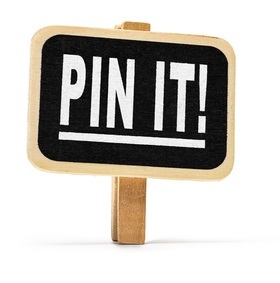Generate Sales through Pinterest

Back to the days of old when you advertised products and services by posting them on a notice board; except now, it is digital. If you are unfamiliar with it, Pinterest is a virtual pin board which operates on the same basis as a social network. The site allows users to create pin boards for their various interests. Pins are collected either by uploading, linking from a website or picking them out of a public pool. Essentially, Pinterest is a content sharing network, a collection of ideas, photos and tips available on almost any topic imaginable.
Why you need it
In the United States alone, a reported 47% of users have bought via Pinterest. With the increased amount of interaction available on the site, you can attract more traffic to your website; generate leads on a daily basis and increase sales. Where about 1% of Tweets are shared, a pin is repinned on average 10 times. The site holds some 70 million users worldwide – which also provides the opportunity of instantly expanding your demographic. Pinterest is also four times more likely to generate sales, when compared with other social networks like Twitter. In terms of promotion on a permissions marketing basis, this is the way to go.
Drive Traffic to your Profile
- Set up a profile, with a user image and user name which is related to your business. Make your profile relatable to fellow pinners by avoiding too much branding – people are more likely to follow a person than an institution.
- Create boards according to your product or service line and also create boards on which you add pins which are not your own (things you re-pin from other users).
- Only pin things that are of interest to both your brand and your followers.
- Rely on images, as visually appealing content attracts more attention. Brand images are more likely to be repined if the image is of a person.
- Have an interactive account, instead of only pining, visit the ‘Popular’ board and comment or like on other people’s pins at most three times a day. Again, only interact with pins that are relatable to your business.
- Follow individuals with similar interests to get ‘follow-backs’.
- Link your profile to your other social networks, Tweet your pins, display them on Facebook and add your Pinterest link to your Facebook or Twitter bio.
- Invite your followers to contribute to your boards that are not dedicated to your business’ products or services.
Pinterest is also a great platform for hosting competitions. Make the first competition requirement a ‘follow-back’. It is best to provide users with three steps to follow in order to enter your competition. Have them follow you, ask them to get a number of people to follow you as well (generating more leads) and request that they pin items to your public board. When creating a competition to promote your brand, make sure the pin has your company logo, a clear call to action, the competition’s end date and a visual description of the prize. In doing all of this, your brand is promoted, you acquire new followers and the user’s pins are a clear indicator of their interests.
Keep your Followers in Mind
To attract followers and to ensure that your pins are exactly what your audience wants. Pinterest is now a popular search engine among its loyal users. It is used to find information, how-to instructions, gift ideas, to find inspiration and lastly, just for fun. Keep this in mind when captioning your pins. The captions will ultimately be the key phrases people search, so they must be worded accordingly.
Pinterest is not as everyone believes; a site for people who like cooking, wedding planning and DIY projects. It is a new kind of platform for businesses. Two years after its launch, the site opened itself up to ecommerce, allowing businesses to register their company profile. With the correct content plan and follower engagement, any business can start selling.
Mari Roelofse is a Digital Journalist & Content Editor for Sound Idea Digital | mari@soundidea.co.za | Sound Idea Digital | www.soundidea.co.za
[Back]
blog comments powered by Disqus
